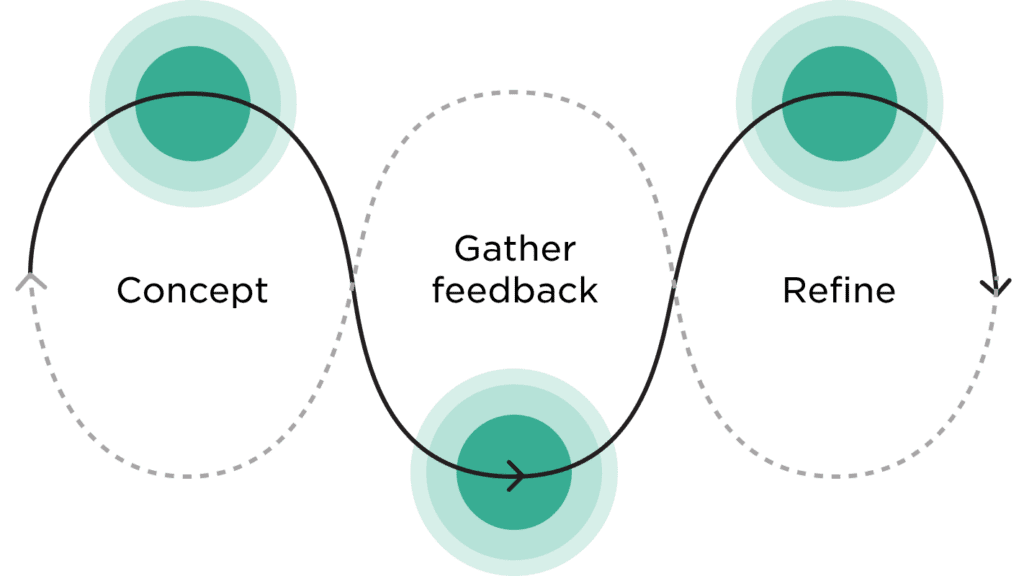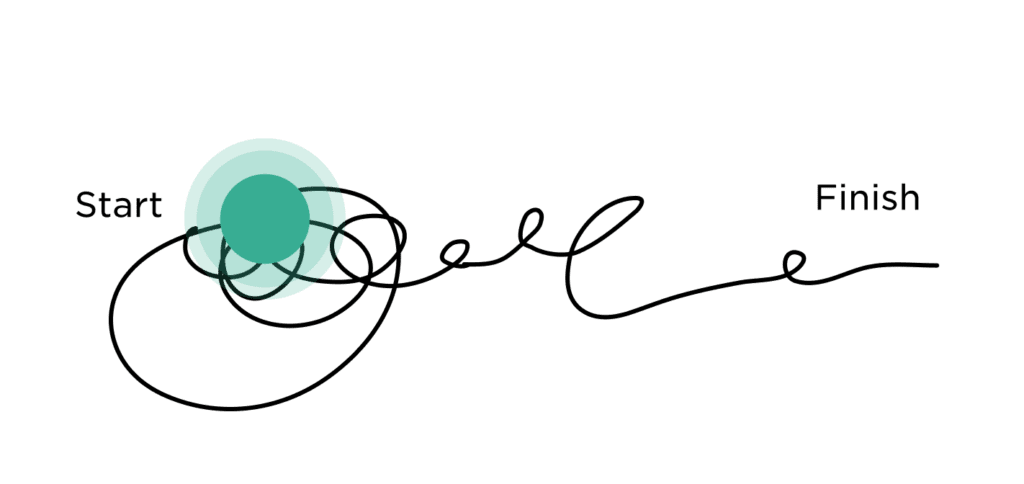Design thinking in the Age of AI
AI is transforming how we live, work, and communicate. With AI’s help, we can move from idea to product launch at super-speed. Never before have we been able to move
▪ September 26, 2025▪ March 20, 2023
Designing a new digital product can be an exciting and challenging task. Whether it’s an innovative feature or a brand-new experience, it takes trial and error to get it right. With the time and effort required to plan, design, build, and market new products, launching with the wrong offering can be risky. The trick is to ensure you’re designing the right thing before you invest too much. And the answer is concept testing.
Concept testing is a method that shifts and shapes your product to align with customers’ needs and expectations. It’s a simple process – create a concept, review it with users, and use the feedback to make decisions.

It’s best done early in the design process when tackling bigger questions. If you can identify your product’s weaknesses and opportunities earlier, you can course-correct before you spend a hefty sum building an experience no one uses.
Beyond determining market fit, concept testing can be a compass for defining your product. Here are a few benefits of concept testing:
You can define and validate an idea.
With concept testing, you can test even the most half-baked ideas to learn if they have any utility. You will learn which parts resonate with customers and where they need more guidance. Most importantly, you will learn whether the new product solves a real need.
You reduce risk.
You’ll likely put your blood, sweat, and tears into your product launch. Concept testing helps you identify what’s not working early in the design process so you can tweak or reconsider the idea before you invest more resources.
You can improve the design.
Another benefit of concept testing is that it can improve the design. It’s a feedback goldmine. Early feedback helps you focus on the right features and refine or rethink ones that don’t meet your users’ needs. Hearing directly from the source will help you smooth the rough edges and highlight areas that need more thought.
You will make better decisions.
Feedback, whether positive or negative, can inform your decision-making. And the journey is just as important as the destination. The concept testing process teaches you more about your user’s needs and goals so you can meet them.

Concept testing is a powerful tool that should be used early in your process. It’s most valuable when you are:
Concept testing helps answer questions like
While concept and usability testing are valuable ways to gather customer feedback, they’re not interchangeable processes. Concept testing happens earlier in the design process when you’re narrowing in on the big idea and requirements. Usability testing usually happens when you’re further refining the design of those solutions.
[gatedcontent-widget id=”2978″]
If your team could benefit from concept testing, the best approach is to jump right in. After researching, brainstorming, and strategy sessions, you likely have many ideas and multiple directions. Choose the strongest and most promising and begin designing a concept. Both data and intuition drive design, so don’t get bogged down in the details. Trust your instincts and go with your gut.
Tell a story.
A good concept provides enough information about the product for users to react to it. First, ask yourself, what are the key questions you have about this direction? Your concept should provoke answers to those questions.
Next, build a flow of screens that help tell the story of the product or feature. For example, if you are adding a new service, start with the home page, where you explain the benefits and how it works. Then you might design a few screens that show what it’s like to use the service.
Design in mid-fidelity.
To see how users will actually use a product, they need to feel like they’re handling the real thing. There’s a sweet spot between low-fidelity and high-fidelity prototypes that can create an authentic simulation without getting too deep into brand colors and detailed UI. Shoot for somewhere in between.
Keep it imperfect.
A good concept only needs to be good enough to get feedback. This should be a fast process that represents the best of your ideas. It won’t be the final version that you launch with. Instead, it should be at a point that you feel perfectly fine if it needs to be scrapped or changed significantly. If you need final assets or a copywriter involved, you’ve missed the point of a concept.

After creating your prototype, it’s important to review it with potential customers and receive feedback. Our preferred method for this is through moderated testing sessions. With moderated concept testing, you have the freedom to adjust your questions as needed. Unlike unmoderated testing or a survey, where you must stick to a specific set of tasks or questions. If a participant mentions something interesting, you can follow that line of thought.
Start with specific topics you and your team have questions about. Then, focus on critical points in the experience that you fear might be risky turns.
Let the concept guide them.
As participants interact with the concept, listen to their reactions. Pay attention to the questions they ask and the assumptions they make. You’ll hear moments of uncertainty and understanding. Use the prototype to derive their understanding of the concept. When they say something like, “Oh, this is a service for cat lovers,” take this opportunity to learn what led them to that conclusion and their assumptions about cat lovers.
Let the concept ignite discussions.
Throughout the experience, participants may have new ideas for the product. They may tell a story about a situation where the product would be helpful or mention how much they love the idea. Use this opportunity to extract more information from them. Ask questions to help create new requirements or shape the product to meet their needs.
What to do if the concept falls flat.
Sometimes, a concept won’t resonate with users at all. When an idea falls flat, taking a step back and learning from the experience is essential. Use this moment as an opportunity to understand your users’ questions, identify what’s holding them back, and discover what would work better for them.

Now that you have data, the next step is to reshape your concept based on the insights gained. You may discover that only minor changes are needed and that you are on the right track.
On the other hand, you might find that you need to make more significant changes – some that will require another round of concept testing. Either way, incorporating concept testing early, before the product is final, will help you make better product decisions and prevent you from going off course.
AI is transforming how we live, work, and communicate. With AI’s help, we can move from idea to product launch at super-speed. Never before have we been able to move
▪ September 26, 2025In product design, few phrases are as common, or as unhelpful, as “it needs more visual polish.” You’ve heard it in critiques, design reviews, Slack threads, and launch meetings. Everyone
▪ August 22, 2025Most progress dashboards in EdTech leave parents to interpret charts and scores on their own. Generative UI offers a more meaningful alternative by translating student data into clear, contextual narratives.
▪ July 7, 2025